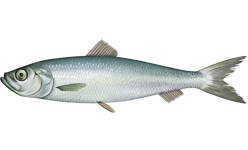
Mackerel is a common name applied to a number of different species of pelagic fish, mostly from the family Scombridae. They are found in both temperate and tropical seas, mostly living along the coast or offshore in the oceanic environment.

Herring are various species of forage fish, mostly belonging to the family of Clupeidae.

Sardine and pilchard are common names for various species of small, oily forage fish in the herring suborder Clupeoidei. The term 'sardine' was first used in English during the early 15th century; a somewhat dubious etymology says it comes from the Italian island of Sardinia, around which sardines were once supposedly abundant.

Sprat is the common name applied to a group of forage fish belonging to the genus Sprattus in the family Clupeidae. The term also is applied to a number of other small sprat-like forage fish. Like most forage fishes, sprats are highly active, small, oily fish. They travel in large schools with other fish and swim continuously throughout the day.

The white-bellied slender opossum is a species of opossum from South America. It is found in Bolivia, Brazil, Ecuador and Peru.
The Niger stingray or smooth freshwater stingray is a species of stingray in the family Dasyatidae, native to rivers in Nigeria and Cameroon. Attaining a width of 40 cm (16 in), this species can be distinguished by its thin, almost circular pectoral fin disk, slightly projecting snout tip, and mostly smooth skin with small or absent dermal denticles. The Niger stingray feeds on aquatic insect larvae and is ovoviviparous. The long stinging spine on the tail of this ray can inflict a painful wound. It has been assessed as Critically Endangered by the International Union for Conservation of Nature (IUCN), as its numbers are declining in some areas and it faces heavy fishing pressure and habitat degradation.
The pincushion ray or thorny freshwater stingray, is a little-known species of stingray in the family Dasyatidae, found in the rivers and lakes of West and Middle Africa. A heavy-bodied ray measuring up to 1.2 m (4 ft) across, this species can be distinguished by its rounded pectoral fin disk, reduced or absent stinging tail spine, and—in adults—numerous stout thorns covering its back and tail. In lieu of a long tail spine as in other stingrays, the pincushion ray employs these thorny denticles in defense. Seldom encountered since it was originally described, this species has been assessed as Critically Endangered by the International Union for Conservation of Nature (IUCN).
Chiloglanis sanagaensis is a species of upside-down catfish endemic to Cameroon where it is only found in the Sanaga River basin. This species grows to a length of 4.3 centimetres (1.7 in) SL.
Synodontis rebeli is a species of upside-down catfish endemic to Cameroon where it occurs in the Sanaga River basin. This species grows to a length of 26.2 centimetres (10.3 in) TL.

An anchovy is a small, common forage fish of the family Engraulidae. Most species are found in marine waters, but several will enter brackish water, and some in South America are restricted to fresh water.
Labeobarbus mbami is a species of cyprinid fish endemic to the Sanaga River basin in Cameroon.
Labeobarbus micronema is a species of cyprinid fish native to Cameroon and Gabon in Africa. It is found in the Sanaga, Nyong, Kribi and Ivindo rivers.
Labeobarbus mungoensis is a species of cyprinid fish endemic to Cameroon in Africa. It is found in the Blackwater, Menge, Mungo and Sanaga river basins.
Labeobarbus versluysii is a species of cyprinid fish endemic to Cameroon in the Wouri, Sanaga and Nyong river basins.

Douala-Edéa National Park, formerly known as Douala-Edéa Wildlife Reserve, is a national park in the Littoral Region of Cameroon.
Sanagia velifera is a species of cyprinid fish endemic to the Sanaga River in Cameroon. It is the only member of its genus. It is threatened by pollution of the Sanaga River by sewage and by the construction of an oil pipeline along the course of the river.

Clupea is genus of planktivorous bony fish belonging to the family Clupeidae, commonly known as herrings. They are found in the shallow, temperate waters of the North Pacific and the North Atlantic oceans, including the Baltic Sea. Two main species of Clupea are currently recognized: the Atlantic herring and the Pacific herring, which have each been divided into subspecies. Herrings are forage fish moving in vast schools, coming in spring to the shores of Europe and America, where they form important commercial fisheries.
Thryssa gautamiensis, the gautama thryssa, is a species of amphidromous ray-finned fish in the family Engraulidae.
Leptocypris crossensis is a species of cyprinid fish found in the Cross, Wouri and Sanaga River basins in Cameroon and Nigeria.

Stichopus noctivagus, commonly known as the night-wandering sea cucumber, is a species of sea cucumber in the family Stichopodidae.









